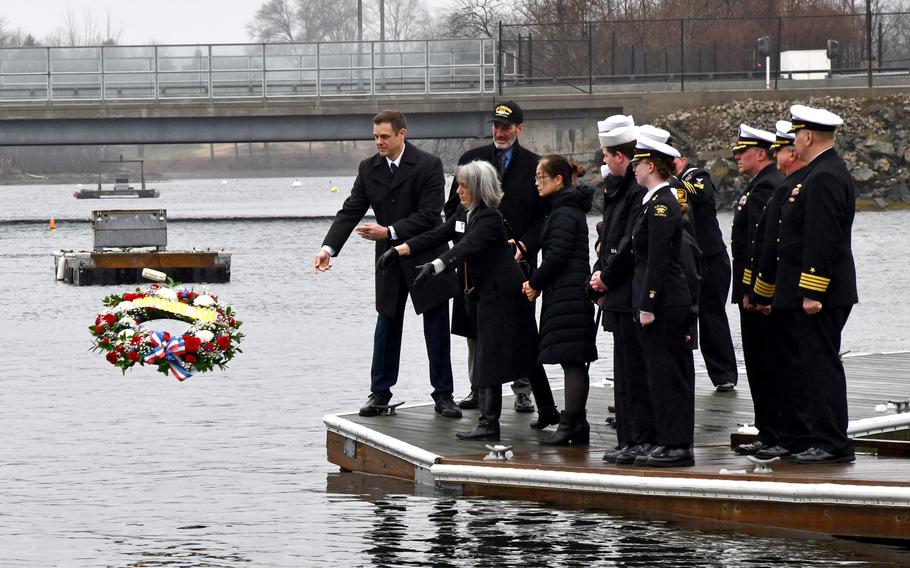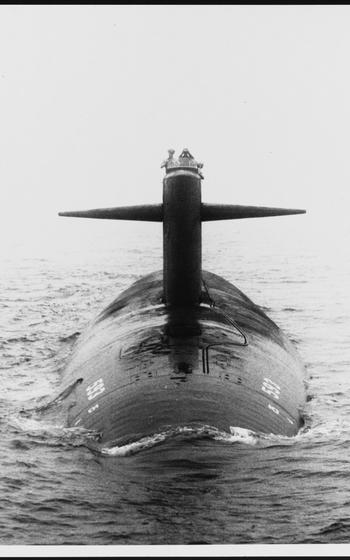
The family of Quartermaster 1st Class Julius F. Marullo, Jr., who was lost on USS Thresher, mark the 62nd anniversary of the tragedy on April 12, 2025, in Kittery, Maine. (James Cleveland/U.S. Navy)
Capt. Joe Meier spoke for everyone in attendance in Kittery, Maine, on Saturday at a ceremony marking the 62nd anniversary of the sinking of the USS Thresher: “We cannot forget what happened.”
Meier, the commander of the Submarine Maintenance Engineering, Planning and Procurement program, was the keynote speaker at a gathering of Navy officials and Thresher families and friends. Meier shared how the memories of those who were lost have fueled the current and future success of submarine safety.
On April 10, 1963, the Thresher, the lead boat of her class of nuclear-powered attack submarines, was on a deep-dive test run off the coast of Cape Cod, Mass. Just after 9 a.m., the captain of another U.S. Navy submarine, submerged nearby, heard the Thresher’s hull collapsing under pressure more than 1,000 feet below the ocean.
All 129 people on board, crew members and shipyard personnel, were killed. The remains of Thresher’s hull were found two months later on the sea floor, about 8,400 feet below the surface, in five major sections.
Representing the Thresher families in offering remarks was Michael Bracey, son of Steward 3rd Class George Bracey, who was among the 96 enlisted sailors on board Thresher that day.
Bracey, who was 4 at the time of the tragedy, shared photos from his father’s life, offering ceremony guests a look into a life cut short. “I never got to know him,” Bracey said.
To conclude the service, the family of lost Quartermaster 1st Class Julius Francis Marullo Jr., cast a wreath along the water’s edge.
The event was hosted by Thresher Base, United States Submarine Veterans Inc. (USSVI), in partnership with Portsmouth Naval Shipyard, at Robert W. Traip Academy in Kittery.

USS Thresher (SSN 593) at sea on July 24, 1961. (Naval History and Heritage Command)
Documents released in 2021 under the Freedom of Information Act showed that the Navy’s policies and procedures failed to keep pace with fast-moving technological advances during the Cold War, The Associated Press reported. Retired Capt. James Bryant, who was the skipper of a Thresher-class submarine, sued for release of the documents.
According to findings in the documents, the ballast system used to surface in an emergency was a legacy system that was never tested at greater depths, and proved to be inadequate, the documents show. There were known problems with the silver-brazed joints in pipes throughout the sub. And training was inadequate for a nuclear reactor shutdown at depth.
The sinking of the Thresher, the deadliest submarine disaster in U.S. history, was a defining moment of the U.S. Navy’s submarine service.
The tragedy led the Navy to implement extensive changes in design, procedure, operations and processes. The Thresher would become synonymous with a new approach to submarine safety through the creation of the Submarine Safety Program, known as SUBSAFE.
“As the commanding officer of SUBMEPP, my job is to ensure the Navy’s submarines remain safe and reliable via a cost-effective lifecycle maintenance plan — the right maintenance at the right time. One of the keys to success in that endeavor is having a strong SUBSAFE culture,” Meier said.
Contributing: The Associated Press